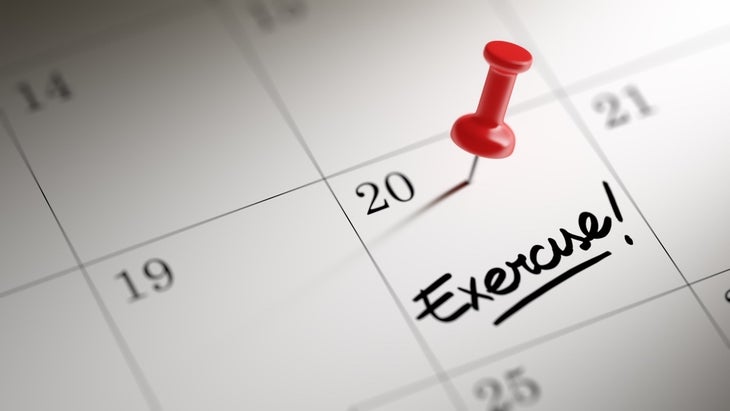Heading out the door? Read this article on the new Outside+ app available now on iOS devices for members! Download the app.
You eat clean. You put in your time and effort — sometimes you’re at the gym four or five days a week. And yet, you’re still not seeing the results you want. What gives? In all likelihood, it’s all in the details. Fine-tune your workout and you’ll reap the benefits.
Even smart women sometimes make dumb mistakes when it comes to improving their physiques. Overcome nine common workout mistakes — and then show off a new lean, tight body.
Not looking at the big picture.

Bodies are smart machines, says Tom Holland, MS, CSCS, author of Marathon Method. “Our bodies adapt very quickly to the stressors we put upon them, so if you’re not changing every four weeks or so, you’ll hit that plateau where your body will no longer continue to change,” says Holland. A periodization plan will produce the most results.
Your Fix: Pre-plan your workouts for a couple of months at a time.
Fast Fact: Just by varying the exercises and the angles at which you train your muscles, you can shock them into growing.
Eating too little.

To improve your physique, forget starvation diets — you want to build your body up, not tear it down, says Kleiner. “You have to consumer enough calories to have enough energy to train hard to build muscle — and then you burn fat,” she says. “You’re never going to be able to exercise hard if you don’t have enough energy to do it.”
Your Fix: Keep small baggies of unsalted nuts, fruits and individual portion of protein powder on hand so you can boost your energy and meet your body’s requirements anytime, any place. It’s all about prep work.
Fast Fact: An active woman needs anywhere from 1,800 to 2,100 calories a day. Don’t save all your calories fro breakfast, lunch and dinner. Build them in with two or three small snacks throughout the day. Ideally, a couple of hours after a meal.
Letting gravity do the work.

Lifting too fast — a common mistake — impacts the results you get from weigh training. “The ‘negative’ [eccentric contraction or down phase of the motion] is the most important factor in lifting,” says Brad Schoenfeld, Ph.D., CSCS. “If you don’t resist the weight on the negative portion, you’re missing out on more than half the exercise.” In fact, research shows that the eccentric, or muscle-lengthening part of the lift, is more important in terms of muscle development than the concentric, or muscle-shortening part. Aim for slow, controlled lifts, taking one to two seconds on the “up” lift and two to four on the “down.”
Your Fix: Try doing this first with lighter weights if you can’t control the weigh ton the eccentric part of the motion. Build the resistance gradually as you get stronger. Change it up by slowing down the concentric (the “up” phase of the motion) as well from time to time.
Fast Fact: Eccentric contractions cause more microscopic tears in the muscles than concentric contractions, which can lead to greater strength and size gains.
Lifting too light.

To change the way you look, you have to challenge your muscles, which means lifting to failure when you weight train. “When you go extremely light, you’re mostly working your type I (slow-twitch) muscle fibers — you’re not getting much contribution from type II (fast-twitch) fibers [the kind that are used during short, high-intensity exercise],” explains Schoenfeld. “Training through a full spectrum of fibers is going to optimize development and ultimately the shape of your muscles.”
Your Fix: Determining the right weight for the right result is trial and error.
Fast Fact: Eight to 12 reps is the best range for building muscle and 12 to 15 reps build endurance and stamina.
Not eating right after your workout.

You work out, shower, get dressed and head to the office. Meanwhile, an hour or more passes and your muscles are starving. Make time for a postworkout meal of carbs and protein. “When you eat immediately after exercise, the calories, carbs and protein…go to fueling your muscles and building your strength,” says registered dietician Susan Kleiner, Ph.D., author of Power Eating (Human Kinetics). Eating within 30 minutes of your workout helps get the nutrients into your cells to start and maximize the recovery process. Even if you can’t make the 30-minute window, the sooner you do eat post-exercise, the better.
Your Fix: Ensure that you eat within a 90-minute time frame. Ideally, a mixture of complex carbs and protein consumed 15 to 30 minutes after your workout is best. Try blending a shake and sticking it in the fridge before you go.
Fast Fact: Your window of opportunity is about 15 to 90 minutes after your last set.
Doing the same-pace cardio all the time.

To get more from your cardio, up the intensity with challenging intervals. “Interval training has been shown to have a greater effect on fat burning than steady-state cardio,” says Schoenfeld. Intervals burn more calories because they’re higher intensity and they increase excess post-exercise oxygen consumption (EPOC), also called postworkout caloric burn.
Your Fix: Throw intervals into the mix. This can be as simple as a two-minute walk/one-minute sprint interval on the treadmill. Keep in mind that higher intensity intervals means you need to cut back on the length of your cardio session.
Fast Fact: EPOC can keep the body burning calories for up to 48 hours after your cardio session.
Not taking enough time off.

Finally, there is such a thing as training too hard. You need time off between strength sessions — at least 48 hours between training the same muscle group — for optimal results. “It is during our periods of rest that we reap the rewards of our training,” says Holland. “Both cardiovascular and strength training cause microscopic tears in the muscle fibers.” On rest days, muscles rebuild and repair themselves, so make sure you take two days between strength sessions of the same muscle group for recovery — and to get more out of your next workout as well.
Your Fix: Don’t just schedule in your cardio and strength training days; schedule in those rest days as well. On your rest days try some activities like biking or yoga.
Fast Fact: Training too hard can lead to overtraining syndrome, which will derail even your best workout intentions as it may lead to fatigue, irritability and potential injury. Be proactive and think about your best, healthy body in the long term.
Not drinking enough water.

Water is necessary for every biomechanical reaction that occurs in your body, including the complicated muscle-building process. “When you aren’t fully hydrated, protein metabolism slows down, which prolongs the repair of your muscles,” says Kleiner. “You don’t have that rapid regeneration of the tissue, and you’re not getting as much bang for your buck.” You get some fluids from foods like fruits and vegetables, but aim for five to six cups of water per day (in addition to other beverages) for optimal hydration.
Your Fix: Keep a one-liter or larger water bottle with your at all times throughout the day and just keep on sipping. Having it right there makes it easier.
Fast Fact: Add about 1.5 liters of water on your workout days to build muscle and strip fat. The more you sweat, the more water you need.
Relying too much on cardio.

Sure, cardio helps you lose body fat, but it does little for muscle tone. “You see women who just do cardio and no strength exercise and they ‘ll have a very stringy appearance, or a thin, flabby look,” says Schoenfeld. In order to develop muscles and change your shape, you have to demand more of them in a short period of time — between 30 and 90 seconds — which is where weights come in. Incorporate cardio and weights into your plan.
Your Fix: Balance your weekly workout plan between cardio and weights, dedicating and equal (if not greater) time to weights. If you have a lot of weight to shed, clean up your diet and you will find the pounds dropping off without overdoing the cardio.
Fast Fact: Muscle burns more calories than fat and increases your resting metabolic rate. That’s more reason to lift.